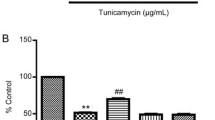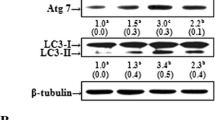Abstract
Endoplasmic reticulum (ER) dysfunction is known to activate the unfolded protein response, which is characterized by the activation of two divergent processes, i.e., suppression of the initiation process in global protein synthesis and expression of glucose-regulated protein 78 (Bip/Grp78) and the C/EBP homologous transcription factor CHOP/Gadd153. In this study, we examined the expression of CHOP/Gadd153 and Bip/Grp78 in human neuroblastoma SH-SY5Y cells treated with 6-hydroxydopamine (6-OHDA), which is used to prepare animal models of Parkinson’s disease. 6-OHDA treatment induced cell death, in a concentration-dependent manner, which was inhibited by co-treatment with an antioxidant N-acetylcysteine. 6-OHDA was also effective in decreasing proteasome activity and in increasing the levels of high molecular ubiquitin-conjugated proteins. Furthermore, 6-OHDA induced a marked increase in the expression of both CHOP/Gadd153 and Bip/Grp78. This increase was prevented by N-acetylcysteine. Taken together, our data indicate that ER dysfunction is at least in part involved in the mechanisms underlying cell death induced by 6-OHDA in SH-SY5Y cells.






Similar content being viewed by others
References
Carman LS, Gage FH, Shults CW (1991) Partial lesion of the substantia nigra: relation between extent of lesion and rotational behavior. Brain Res 553:275–283
Chung KK, Zhang Y, Lim KL, Tanaka Y, Huang H, Gao J, Ross CA, Dawson VL, Dawson TM (2001) Parkin ubiquitinates the alpha-synuclein-interacting protein, synphilin-1: implications for Lewy-body formation in Parkinson disease. Nat Med 7:1144–1150
Cohen G, Farooqui R, Kesler N (1997) Parkinson disease: a new link between monoamine oxidase and mitochondrial electron flow. Proc Natl Acad Sci USA 94:4890–4894
Daimier P, Hirsch EC, Agid Y, Graybiel AM (1999) The substantia nigra of the human brain. II Patterns of loss of dopamine-containing neurons in Parkinson’s disease. Brain 122:1401–1402
Dauer W, Przedborski S (2003) Parkinson’s disease: mechanisms and models. Neuron 39:889–909
Dawson TM, Dawson VL (2003) Molecular pathways of neurodegeneration in Parkinson’s disease. Science 302:819–822
Faucheu BA, Martin ME, Beaumont C, Hauw JJ, Agid Y, Hirsch EC (2003) Neuromelanin associated redox-active iron is increased in the substantia nigra of patients with Parkinson’s disease. J Neurochem 86:1142–1148
Fawcett TW, Martindale JL, Guyton KZ, Hai T, Holbrook NJ (1999) Complexes containing activating transcription factor (ATF)/cAMP-responsive-element-binding protein (CREB) interact with the CCAAT/enhancer-binding protein (C/EBP)-ATF composite site to regulate Gadd153 expression during the stress response. Biochem J 339:135–141
Gething MJ, Sambrook J (1990) Transport and assembly processes in the endoplasmic reticulum. Semin Cell Biol 1:65–72
Gething MJ, Sambrook J (1992) Protein folding in the cell. Nature 6355:33–45
Gilbert JJ, Kish SJ, Chang LJ, Morito C, Shannak K, Hornykiewicz O (1988) Dementia, parkinsonism, and motor neuron disease: neurochemical and neuropathological correlates. Ann Neurol 24(5):688–691
Harding HP, Zhang Y, Ron D (1999) Protein translation and folding are coupled by an endoplasmic reticulum-resident kinase. Nature 397:271–274
Haze K, Yoshida H, Yanagi H, Yura T, Mori K (1999) Mammalian transcription factor ATF6 is synthesized as a transmembrane protein and activated by proteolysis in response to endoplasmic reticulum stress. Mol Biol Cell 10:3787–3799
Imai Y, Soda M, Inoue H, Hattori N, Mizuno Y, Takahashi R (2001) An unfolded putative transmembrane polypeptide, which can lead to endoplasmic reticulum stress, is a substrate of Parkin. Cell 105:891–902
Kanesaki T, Saeki M, Ooi Y, Suematsu M, Matsumoto K, Sakuda M, Saito K, Maeda S (1999) Morphine prevents peroxynitrite-induced death of human neuroblastoma SH-SY5Y cells through a direct scavenging action. Eur J Pharmacol 372:319–324
Kaufman RJ (1999) Stress signaling from the lumen of the endoplasmic reticulum: coordination of gene transcriptional and translational controls. Genes Dev 13:1211–1233
Kitada T, Asakawa S, Hattori N, Matsumine H, Yamamura Y, Minoshima S, Yokochi M, Mizuno Y, Shimizu N (1998) Mutations in the parkin gene cause autosomal recessive juvenile parkinsonism. Nature 392:605–608
Kozutsumi Y, Segal M, Normington K, Gething MJ, Sambrook J (1988) The presence of malfolded proteins in the endoplasmic reticulum signals the induction of glucose-regulated proteins. Nature 332:462–464
Kumar R, Agarwal AK, Seth PK (1995) Free radical-generated neruotoxicity of 6-hydroxydopamine. J Neuochem 65:1906
Kuzuhara S, Mori H, Izumiyama N, Yoshimura M, Ihara Y (1988) Lewy bodies are ubiquitinated. A light and electron microscopic immunocytochemical study. Acta Neuropathol 75:345–353
Li K, Ito H, Tanaka K, Hirano A (1997) Immunocytochemical-co-localization of the proteasome in ubiquitinated structures in neurodegenerative diseases and the elderly. J Neuropathol Exp Neurol 56:125–131
McNaught KS, Belizaire R, Isacson O, Jenner P, Olanow CW (2003) Altered proteasomal function in sporadic Parkinson’s disease. Exp Neurol 179:38–46
Mosmann T (1983) Rapid colorimetric assay for cellular growth and survival: application to proliferation and cytotoxicity assays. J Immunol Methods 65:55–63
Nakagawa T, Zhu H, Morishima N, Li E, Xu J, Yankner BA, Yuan J (2000) Caspase-12 mediates endoplasmic reticulum-specific apoptosis and cytotoxicity by amyloid-beta. Nature 403:98–103
Ogawa N, Asanuma M, Kondo Y, Hirata H, Nishibayashi S, Mori A, (1994) Changes in lipid peroxidation, Cu/Zn-superoxide dismutase and its mRNA following an intracerebroventricular injection of 6-hydroxydopamine in mice. Brain Res 646:337–340
Pelham HR (1989) Control of protein exit from the endoplasmic reticulum. Annu Rev Cell Biol 5:1–23
Riederer P, Konradi C, Hebenstreit G, Youdim MB (1989) Neurochemical perspectives to the function of monoamine oxidase. Acta Neurol Scand Suppl 126:41–45
Smythies J (2000) Redox aspects of signaling by catecholamines and their metabolites. Antioxid Redox Signal 2:575–583
Sofic E, Lange KW, Jellinger K, Riederer P (1992) Reduced and oxidized glutathione in the substantia nigra of patients with Parkinson’s disease. Neurosci Lett 142:128–130
Soto OR, Mendez AE, Hermida AA, Munoz PM, Labandeira GL (2000) Autooxidation and neurotoxicity of 6-hydroxydopamine in the presence of some antioxidants: potential implication in relation to the pathogenesis of Parkinson’s disease. J Neurochem 74:1605–1612
Vroegop SM, Decker DE, Buxser SE (1995) Localization of damage induced by reactive oxygen species in cultured cells. Free Radical Biol Med 18:141–151
Vu PK, Sakamoto KM (2000) Ubiquitin-mediated proteolysis and human disease. Mol Genet Metab 71:261–266
Wang XZ, Kuroda M, Sok J, Batchvarova N, Kimmel R, Chung P, Zinszner H, Ron D (1998) Identification of novel stress-induced genes downstream of chop. EMBO J 17:3619–3630
Wang XZ, Lawson B, Brewer JW, Zinszner H, Sanjay A, Mi LJ, Boorstein R, Kreibich G, Hendershot LM, Ron D (1996) Signals from the stressed endoplasmic reticulum induce C/EBP-homologous protein (CHOP/GADD153). Mol Cell Biol 16:4273–4280
Welihinda AA, Tirasophon W, Kaufman RJ (1999) The cellular response to protein misfolding in the endoplasmic reticulum. Gene Expression 7:293–300
Yoshida H, Haze K, Yanagi H, Yura T, Mori K (1999) Identification of the cis-acting endoplasmic reticulum stress response element responsible for transcriptional induction of mammalian glucose-regulated proteins. Involvement of basic leucine zipper transcription factors. J Biol Chem 274:2592
Zhang Y, Gao J, Chung KK, Huang H, Dawson VL, Dawson TM (2000) Parkin functions as an E2-dependent ubiquitin-protein ligase and promotes the degradation of the synaptic vesicle-associated protein, CDCrel-1. Proc Natl Acad Sci USA 97:13354–13359
Zigmond MJ, Stricker EM (1984) Parkinson’s disease: studies with an animal model. Life Sci 35:5–18
Author information
Authors and Affiliations
Corresponding author
Rights and permissions
About this article
Cite this article
Yamamuro, A., Yoshioka, Y., Ogita, K. et al. Involvement of Endoplasmic Reticulum Stress on the Cell Death Induced by 6-Hydroxydopamine in Human Neuroblastoma SH-SY5Y Cells. Neurochem Res 31, 657–664 (2006). https://doi.org/10.1007/s11064-006-9062-6
Accepted:
Published:
Issue Date:
DOI: https://doi.org/10.1007/s11064-006-9062-6




